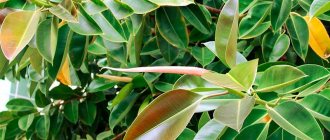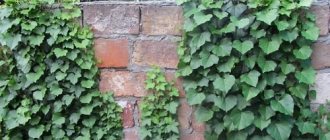Plants » Flowers
1
2606
Article rating
Kira Stoletova
Ficus is a very common indoor plant. Of all its varieties, the most popular is the Variegated Ficus. It fits perfectly into any interior and for many has already become an excellent addition to the collection of indoor plants.
Variegated ficus
In order for the ficus to please the eye, it is necessary to properly care for it, otherwise the plant will lose its unusual color or die altogether.
Varieties of variegated ficus
There are a huge number of varieties of ficus. They are so different from each other that a beginner in this business will not be able to understand whether it is a ficus in front of him or not.
The following variegated types are distinguished:
- Ficus rubber is a plant that has a thick stem and reaches 2-2.5 m without timely pruning. The leaves are large, fleshy, oval in shape. Variegated varieties: Black Prince, Variegata, Robusta.
- Pumila, or dwarf ficus, is a creeping plant (ampeloid). It has shoots up to 5 m long. The leaves are miniature in the shape of a heart. Variegated species: Sunny, White Sunny, Dorta.
- Ficus Binnedijka Ali is an unpretentious ornamental tree with elongated oval leaves. In nature, its height exceeds 20 m, but in indoor conditions it is no more than 2-2.5 m. With proper pruning, it grows a lush crown in a very short time. Variegated species: Amstel Gold, Amstel King.
- Ficus rustifolia is a low bush native to Australia. The leaves are dark green in color with a milky pink edge. There is a red fluff on the back of the leaf.
- Ficus Benjamin is a tree-like plant with medium-sized leaves. The most common variety among indoor flower lovers. Variegated varieties: Anastasia, Baroque, Daniel, Midnight Lady.
All these varieties grow successfully indoors with proper care. Ficus Binnedijka Ali is perfect for beginner gardeners. It is absolutely unpretentious and can easily tolerate drought and hot weather.
Does Ficus Benjamina bloom?
Flowering ficus Benjamin in captivity is an extremely rare sight. It is usually achieved in special greenhouses, where ideal conditions are maintained that replicate the plant’s natural habitat.
Ficus flowers are far from traditional ideas. They are called syconia and are small balls with a small hole, hollow inside. They can only be pollinated by insects that live in tropical latitudes. The flowers differ from variety to variety, but are mainly painted in bright colors: white, yellow, orange.
The fruits of ficus are inedible, they look like small red berries (as they ripen they change color to burgundy).
Ficus benjamina flowering
In fact, due to difficulties with pollination, it is possible to achieve flowering of ficus at home, but it is very difficult. But growing fruits, and even with seeds, is a truly rare and almost impossible task in captivity.
The soil
To plant ficuses, breathable, light and loose soil is required. This is due to the fact that the dense consistency of the soil guarantees stagnation of moisture, and these plants do not like this. Most often, pots are filled with a substrate consisting of:
- sand;
- clay granulate or expanded clay;
- peat;
- leaf humus;
- turf land.
Ficuses do not like acidic soil, and the soil should have neutral acidity, or, in extreme cases, be slightly acidic. To reduce acidity, you can add a little dolomite flour or quicklime to the soil. Among other things, they enrich the substrate with calcium and magnesium. Potassium and phosphorus are vital for indoor ornamental trees. These microelements help maintain the marbled color of the leaves. Wood ash is rich in them.
Some gardeners recommend adding brick or stone chips to the soil: this gives the roots the opportunity to breathe and does not allow water to stagnate.
What are the methods of reproduction?
The most optimal period for breeding new specimens will be the end of the spring months, or, in extreme cases, the beginning of summer. Then the sprouts will definitely have time to take root and gain strength.
Ficus benjamina propagation by cuttings in water
For cuttings, take the top young branches of 10-15 cm, which are slightly lignified. Be sure to cut them only with a sharp knife and at an angle. The juice that will be released from the cut needs to be washed off; to do this, you can place the cutting in water for a while.
If you root cuttings in water, then you can add an activated carbon tablet there for disinfection, and the water should be constantly changed and not stagnate. Remove the lower leaves so that they do not waste energy and do not touch the water. As soon as tender roots appear, you can plant them in a prepared container with soil.
It is possible to root cuttings directly into the soil. The juice still needs to be removed, the cut should be sprinkled with coal and placed in a pot at the level of one bud. The young cutting is covered with a jar or film, the so-called “greenhouse effect”.
Seed propagation
Growing ficus from seeds is a rather labor-intensive process and not everyone can do it. It is usually used in laboratory conditions.
Watering
Ficus plants are demanding when it comes to watering - it should be done frequently, but in small portions of settled water so that moisture does not stagnate in the soil.
Since ficuses come from tropical countries, they need high air humidity. It’s not difficult to organize this at home; it’s enough to spray your indoor flower with a spray bottle 1-2 times a day. In winter, when the ficus is dormant, spraying and watering are reduced.
It is useful to give your indoor plants a hygienic shower. Before the procedure, cover the soil in the pot with plastic wrap and wash the ficus from the shower with water at room temperature. It is recommended to wash ornamental trees no more than once every 4-5 months.
Pests and diseases
Pests of Ficus Benjamin and its varieties do not attack so often. Most often, gardeners encounter spider mites that feed on plant sap. The reason for its appearance is high air temperature and low humidity. Despite the fact that the mite settles on the inner plate of the leaf, it is impossible not to notice it, since the flower is entwined with a light cobweb.
It is necessary to begin the fight against the parasite as soon as the problem is noticed. In the early stages, it is enough to wash the leaves with a soapy solution. If this does not help, treatment with insecticides should be carried out. In some cases, lowering the temperature and increasing air humidity can solve the problem.
As for diseases, most often the cause of their occurrence lies in the lack of sunlight. In this case, the variegated one begins to shed its leaves, and the trunk actively reaches towards the sun. Turning on a fluorescent lamp or moving the plant to a window can quickly solve the problem.
Simple ficus care will allow the gardener to enjoy the beauty of this amazing flower.
Top dressing
In spring and summer, during the period of active growth of shoots and root systems, ficus plants need mineral feeding. An excellent solution would be nitrogen-containing fertilizers. The lack of this substance inhibits the growth of deciduous mass.
Among other things, potassium, calcium and phosphorus are vital for indoor flowers. In order not to calculate the dosage for a certain volume of land, you can use ready-made fertilizers. These complex fertilizers only need to be diluted with water and watered the plant.
In autumn and winter, when the growing season ends and the ficus is at rest, feeding is stopped: not only will it not bring any benefit, but it is also harmful to the plant.
Transfer
Care at home gives results if the plant is systematically replanted in a pot of suitable size. This must be done carefully. Sometimes the transplant is not planned, but emergency. If the ficus is “overfed” with fertilizers, it will have to be replanted with a complete replacement of the substrate.
A signal that the plant requires replanting is that the soil in the pot dries out quickly, and the pot itself is overfilled with small roots. The pot is taken 5-6 cm wider than the previous one.
In order to carry out a transplant with minimal damage to the rhizome, it is recommended to carry out a number of manipulations:
- Moisten the soil in the pot and remove the top layer as carefully as possible by 2 fingers.
- Place drainage at the bottom of the new pot. This can be special clay granules, stone chips, shells or pebbles.
- Lay a layer of new substrate. It is recommended to compact it slightly.
- Using light tapping movements, shake the rhizome out of the old pot. At this time, the shoots need to be supported by hand. If the ficus is large, then you will need help; you can’t do it alone.
- Place the rhizome in a new pot and fill the free space with substrate.
- If a young plant was transplanted, then there is no need to compact the soil: this interferes with the natural ventilation of the roots. But large ficuses should be compacted well, because under their weight they can simply turn out of the pot.
After transplantation, the ficus may stop growing for some time. This is normal, because the root system is growing. If the pot is too large, the process may take longer.
Signs and superstitions
People have endowed many indoor plants with special properties. Ficus benjamina is no exception; many are interested in whether it can be placed in residential premises. The cause of concern is the unenviable reputation among the Slavic peoples. This plant is considered a muzhegon. A single woman can only get married if she gets rid of this plant. If there is a man in the house, the ficus will definitely kick him out. This superstition is typical only for the Slavs; in Thailand and China they think differently.
People who follow the rules of Feng Shui believe that
ficus benjamina has positive energy , neutralizes aggression, and helps solve important problems.
In China, it is given to elderly people to prolong their lives. In Thailand, ficus is one of the elements of the coat of arms, as it drives away evil spirits and brings good luck. The first statement has been confirmed by scientists. This plant absorbs benzene, ammonia, and formaldehyde from the air.
In Russia, before the revolution, many people grew ficus benjamina; it was believed that they balanced relationships in the family and helped build a career. Later, this opinion began to be considered a relic, but ficus trees were still bred. After the war, someone noticed that the men did not return to the houses in which the ficus benjamina stood. This radically changed the attitude.
Opinion of modern Russians:
- Benjamin's ficus balances relationships, but gets sick from negativity;
- when placed in the kitchen, well-being increases;
- in the bedroom, ficus relieves insomnia and promotes conception;
- efficiency increases in the office.
Signs are just folklore. You can be interested, but you also need to analyze the information. Any plant is alive, therefore it requires care and reacts to people’s emotions. If you treat Benjamin's ficus kindly, he will respond in kind.
Lighting
The presence of a sufficient amount of sunlight is the key to normal growth of the ficus, as well as maintaining its color. Due to insufficient lighting, the leaves fade, and the young shoot grows not variegated, but green. Even if this ornamental tree later receives normal lighting, the pigmentation of the leaves will remain the same. Sometimes the ficus even sheds its leaves due to the short daylight hours.
It is recommended to think in advance where exactly the pot with the indoor flower will be placed, because it does not like changing place. It is better to put it on the south window. The fucus needs to be turned to the sun with different sides, otherwise the foliage will grow on only one side.
The love of ornamental trees for the sun does not mean that they need direct sunlight. They may get sunburned. A leaf that was green or variegated turns brown and eventually falls off. During the summer heat, it is better to cover the ficus from the sun with paper or something similar.
Growing conditions
For the most part, standard indoor conditions work well for growing ficus benjamina. Particular attention should be paid perhaps to lighting and maintaining humidity - a flower is almost always particularly demanding about these characteristics.
Temperature
The best temperature for ficuses in the summer should not significantly exceed +24-25°C. The optimal range is considered to be +19-23°C.
In winter, the best temperature will be +15-16°C. Although you can often hear that ficus trees can easily withstand severe cold weather. True, only for a short time.
Air humidity
Maintaining soil and air moisture is an important quality that must be carefully and carefully monitored.
Ficuses love high humidity. This is why they need to be watered every day during the summer months. The greens should be sprayed periodically through a sprayer.
Advice. Ficus benjamina, for example, would benefit from a good shower in the bathroom. Firstly, this will create sufficient conditions for soil moisture and greenery, and secondly, get rid of pests such as spider mites or scale insects and their nests.
In autumn, and then in winter, moisture should be reduced, gradually increasing the frequency of watering to once a week. In the coldest decade of the year, you should also not spray the leaves with a spray bottle.
Working heating, which dries out the air in the rooms, can cause great inconvenience in winter. Then it is recommended to increase the humidity. The best way is to use an automatic humidifier. Or you can give preference to the old proven method - leave a saucer of water next to the ficus.
Lighting
In terms of lighting, ficus benjamina does not like direct sunlight. Otherwise, the leaves will quickly wither or even suffer from heat burns. As a last resort, exposure to non-aggressive sun at sunrise or sunset is allowed.
But ficus bushes love diffused natural light. In the conditions of central Russia, there is enough daylight only in summer. In other seasons, additional lighting with artificial lamps may be required. But only if there is a desire to quickly grow a tree to a large size.
Where to put a flower pot
It is believed that the ideal location for a pot of Ficus Benjamin is windows and balconies facing east or west.
The south side can be dangerous because the sun stays there most of the day. This will be very harmful for the foliage.
On the north side there may not be enough light, which is why the bush will grow weakly and generally get sick often.
During the summer months, it is recommended to move ficuses to fresh air. A good place in the apartment can be a balcony (for the whole season). And in the southern regions you can even take the flower outside, but place it in a shady place.
It is better to place the ficus on a western or eastern window
When the tree grows to a large size (up to a maximum of 2-3 meters), it can be permanently left in the corner of the room, but choose the location in such a way that the nearest radiators are at least 1.5 meters away.
What does it look like in the interior?
Ficus benjamina is an evergreen plant that looks equally good in the interior in both winter and summer. The bush looks especially impressive when mature, enriching an indoor greenhouse.
The plant perfectly complements modern types of interiors. The main visual qualities of the ficus are the special shape of the trunk, which is an interweaving of woody roots, and a lush, neat crown. Small decorative varieties that do not grow more than 20-30 cm are perfect for decorating living rooms and kitchens.
Ficus benjamina in the interior
Trimming
In the wild, ficus trees grow in height and rarely send out side shoots, but in a house or apartment this is not possible. Among other things, a bare stick with a leafy top does not look very good as an ornamental plant. In order to give the ficus a beautiful shape, it is necessary to resort to pruning.
In photos on the Internet you can see trees and bushes, but they are the same plants. If you cut off the apical bud, the side shoots are activated. It is for this purpose that the crown of the plant is cut off.
Pruning is done in early spring, until the indoor flower has completely moved away from winter dormancy.
It is not recommended to leave the tree completely without leaves: they perform the function of photosynthesis and thereby provide the plant with energy. The leaves are green because of the chlorophyll they contain. It is he who synthesizes starch from sunlight.
If the plant has lost its decorative properties or the trunk is too elongated, rejuvenating pruning can be done. To do this, cut off the trunk completely 10 cm above the ground. The cut is treated with potassium permanganate and the rhizome is transplanted into a larger pot, replacing the substrate with a more nutritious one. After a couple of weeks, new young shoots appear. The remaining leafy part can be used to propagate ficus by cuttings.
For any pruning, you must strictly adhere to the following rules:
- Pruning is carried out only in early spring.
- The cut on the shoots is made straight, and on the trunk - obliquely.
- After pruning, you need to remove the milky sap with warm water and a sponge.
- A knife, scalpel or garden shears should be disinfected before pruning.
- The cut is treated with potassium permanganate or special pastes sold in flower shops.
- Feeding is carried out no earlier than 2 weeks after stripping.
With proper pruning you can get a beautiful and healthy plant. In addition to being decorative, pruned trees are more likely to grow foliage and suffer less disease.
Botanical description of the plant
Ficus benjamina (lat. Ficus benjamina) is a species of plant from the genus Ficus of the Mulberry family. An evergreen tree or shrub, in the wild it grows up to 20-30 m in height. Distributed in India, China, Southeast Asia, the Philippines, and northern Australia.
The leaves of Ficus Benjamin are glossy, smooth, thinly leathery, oblong-oval with a pointed apex, 6-13 cm long and 2-6 cm wide. The arrangement of leaves on the branches is opposite, the leaves are formed in the same plane. The edge of the leaf is entire. The venation is reticulate, the central vein is weakly expressed, with 8-12 pairs of lateral veins. The petiole is about 2 cm.
The bark is gray with rare brown streaks. The crown is wide, the branches are drooping. The fruits of Ficus Benjamin - syconia - are round or oblong, paired, up to 2 cm in diameter, red or orange, inedible.
Problems you may encounter
The variegated decorative ficus and its care bring only joy to those people who really love indoor plants.
But ficuses get sick, and the reason for this is improper care, as well as an initially infected seedling or soil.
When growing an indoor flower, you may encounter the following problems:
- Black dots on the back of the leaves are cercospora blight. A fungus that infects green leaves spreads spores and can infect other houseplants. The affected leaves are cut off, and the entire ficus is treated with a fungicide.
- Spider mites are small creatures that attack the leaves of ornamental trees. They are easy to spot by the thin webs that wrap around the branches and trunk, as well as white spots on the foliage. The plant is washed under warm running water, and the leaves are wiped with alcohol.
- Dropsy is brown growths on the leaves formed due to overwatering of the soil. Leaves with growths are removed, and the plant is transplanted into a new substrate.
Answers to popular questions
Why doesn't it grow well?
Poor growth of any ficus is often associated with a lack of daylight. Another reason lying on the surface is the lack of necessary minerals in the soil. Finally, too dry air is also a common problem in most rooms where ficus grows.
Why does it wither?
The wilting of ficus foliage is a natural process that occurs every spring. Abundant fertilizing after wintering will help reduce the wilting time.
On an adult plant, leaves can wither at any other time of the year. Unfortunately, the reason almost always lies in the excessively dry air in the rooms. Automatic humidifiers or placing dishes with water next to the pot to naturally evaporate moisture will help get rid of this.
Why do the leaves fall
In general, moderate leaf loss is normal for ficus trees. If a flower loses a lot of green cover, and does so abruptly, then the environmental conditions are unsuitable for it.
You should check whether the ficus is bothered by drafts and how much the temperature in the room has changed. It is possible that leaf fall can be corrected in a timely manner if the plant is returned to its previous conditions.











